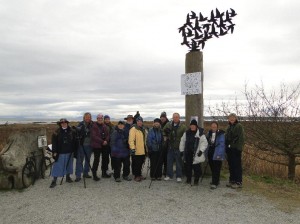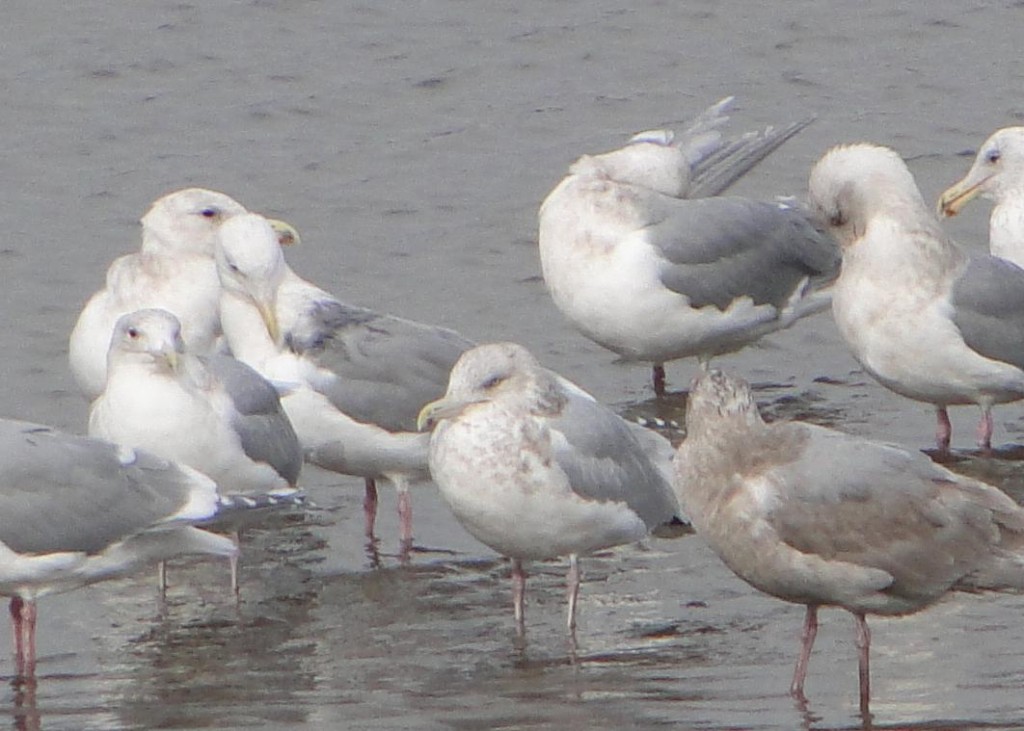A group of 11 ABC birders joined Charlie Wright and Ken Brown on a gull study outing in south King and Pierce counties on what started as a very rainy Saturday, but ended up with some unexpected but much appreciated sunshine at the log booms in Tacoma. Ken plan the trip to begin in Pierce County and move to King County in the afternoon but because of the heavy rain in Pierce County in the morning we instead went directly to the Gene Coulon Memorial Beach Park on Lake Washington where we could bird from the cover of the cupola there. As was the trend for the day we didn’t find large numbers of gulls but enjoyed careful study of what we did find.
For me one of the highlights of the day was having Charlie show us how to use the new iPhone and android app Bird’s Eye Birdlog NA. Using this app it’s relatively easy to log the time you start birding area enter the species and numbers of individuals seen and then submit the list thereby ending the time at the site directly to your E-bird database. For me I’m hopeful that this app will give me incentive to keep better records and lend my tiny support to this tremendous resource for birders.
At Coulon Park we didn’t have large numbers of gulls but got excellent views of all three age groups of Mew Gulls as well as five Glaucous-winged gulls and a Glaucous-winged by Western hybrid. The small number of gulls may have been in part due to the second cycle Bald eagle that flew in and roosted on a post right in front of us.
Our next stop was at the Foster golf links in King County near the Yellow Truck company lot and the BECU headquarters. Although large numbers of goals are seen here at times we pretty much struck out seeing just one Mew Gull and a single Glaucous-winged Gull. From here we stopped at the Tukwila gull spot where our luck remained about the same. After struggling to find gulls in King County were decided to return to Pierce County and our first stop got us off to a better start at the McDonald’s near the tide flats. There we had a Western gull along with a few hybrids and a single Glaucous-winged gull.
Things were starting to look up as the rain was diminishing nicely and from there we spent the bulk of the day at the Gog-Li-Hi-Ti wetlands. Gulls were present in modest numbers but excellent variety. Charlie and Ken both noted that unlike midwinter when a nice flock of adult Thayer’s gulls is usually present the majority of the Thayer’s gulls we saw there were first cycle birds with a few second cycle birds mixed in and far less adults than is seen in midwinter. The stop was an excellent opportunity to study molt and a good number of most of the common gulls in various age groups. We added Herring gull and were all pretty much blown away that Charlie identified both of them in about a millisecond on-the-fly. We used Ken’s tried-and-true technique of teaching with Charlie leading the way starting on one edge of a ridgeline and moving through the individual birds and talking to us about their identification and usually aging the birds as well. I think all of us came away at least a little bit better at gull identification after this exercise.
Next we were off to the Port of Tacoma the end of Alexander street where from the parking lot we picked up our first Bonaparte’s gulls of the day fairly far out on the water, some of which were coming nicely into their alternate plumage. It was fun to see my first black headed gulls of the year and most of us saw our first Caspian Tern of the year too. We also got to study a first cycle Least sandpiper and got a good laugh at Ken’s reminder that it had three ages of feathers noted, it’s juvenile primaries were looking pretty worn. It was mostly in its formative plumage with a few first alternate feathers noted on the mantle and back. One more opportunity to study molt, of if you are Diane to stay away and cover your ears.
Last at the log booms on Marine view Drive we had sunshine. As we marveled at getting a break in the weather on the latter half of our day we also got great looks alternate plumage Brandt’s cormorants, added a variety of other water birds tour day list and tried for at a seventh species of full for the day but we the hoped-for California gull didn’t materialize.
All of us are grateful that to Charlie for bringing fresh energy and tremendous expertise to our study of gulls and of course to Ken for his continued tutelage and great trip-leading skills. I hopt to see you all of at the next ABC meeting.





